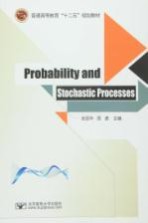

概率论与随机过程PDF电子书下载
- 电子书积分:12 积分如何计算积分?
- 作 者:张丽华主编
- 出 版 社:北京:北京邮电大学出版社
- 出版年份:2015
- ISBN:9787563545377
- 页数:325 页
Chapter 1 Events and Their Probabilities 1
1.1 The History of Probability 1
1.2 Experiment,Sample Space and Random Event 3
1.2.1 Basic Definitions 3
1.2.2 Events as Sets 5
1.3 Probabilities Defined on Events 8
1.3.1 Classical Probability 8
1.3.2 Geometric Probability 13
1.3.3 The Frequency Interpretation of Probability 16
1.4 Probability Space 18
1.4.1 Axiomatic Definition of Probability 19
1.4.2 Properties of Probability 20
1.5 Conditional Probabilities 24
1.5.1 The Definition of Conditional Probability 24
1.5.2 The Multiplication Rule 28
1.5.3 Total Probability Formula 30
1.5.4 Bayes'Theorem 32
1.6 Independence of Events 37
1.6.1 Independence of Two Events 37
1.6.2 Independence of Several Events 40
1.6.3 Bernoulli Trials 44
1.7 Review 45
1.8 Exercises 46
Chapter 2 Random Variable 54
2.1 The Definition of a Random Variable 54
2.2 The Distribution Function of a Random Variable 57
2.2.1 The Definition and Properties of Distribution Function 57
2.2.2 The Distribution Function of Function of a Random Variable 67
2.3 Mathematical Expectation and Variance 71
2.3.1 Expectation of a Random Variable 71
2.3.2 Expectation of Functions of a Random Variable 77
2.3.3 Variance of a Random Variable 80
2.3.4 The Application of Expectation and Variation 85
2.4 Discrete Random Variables 87
2.4.1 Binomial Distribution with Parameters n and p 87
2.4.2 Geometric Distribution 92
2.4.3 Poisson Distribution with Parametersλ 95
2.5 Continuous Random Variables 98
2.5.1 Uniform Distribution 98
2.5.2 Exponential Distribution 102
2.5.3 Normal Distribution 107
2.6 Review 114
2.7 Exercises 117
Chapter 3 Random Vectors 126
3.1 Random Vectors and Joint Distributions 126
3.1.1 Random Vectors and Joint Distributions 127
3.1.2 Discrete Random Vectors 129
3.1.3 Continuous Random Vectors 134
3.2 Independence of Random Variables 141
3.3 Conditional Distributions 148
3.3.1 Discrete Case 148
3.3.2 Continuous Case 150
3.4 One Function of Two Random Variables 153
3.4.1 Discrete Case 153
3.4.2 Continuous case 157
3.5 Transformation of Two Random Variables 164
3.6 Numerical Characteristics of Random Vectors 167
3.6.1 Expectation of Sums and Products 167
3.6.2 Covariance and Correlation 170
3.7 Multivariate Distributions 178
3.7.1 Distribution Functions of Multiple Random Vectors 178
3.7.2 Numerical Characteristics of Random Vectors 181
3.7.3 Multiple Normal Distribution 186
3.8 Review 188
3.9 Exercises 191
Chapter 4 Sequences of Random Variables 200
4.1 Family of Distribution Functions and Numerical Characteristics 201
4.2 Modes of Convergence 204
4.3 The Law of Large Numbers 207
4.4 The Central Limit Theorem 210
4.5 Review 214
4.6 Exercises 215
Chapter 5 Introduction to Stochastic Processes 218
5.1 Definition and Classification 218
5.2 The Distribution Family and the Moment Functions 222
5.3 The Moments of the Stochastic Processes 223
5.3.1 Mean,Autocorrelation and Autocovariance 224
5.3.2 Cross-correlation and Cross-covariance 227
5.4 Stochastic Analysis 228
5.5 Review 231
5.6 Exercises 231
Chapter 6 Stationary Processes 234
6.1 Stationary Processes 234
6.1.1 Strict Stationary Processes 234
6.1.2 Wide Stationary Processes 236
6.1.3 Joint Stationary Processes 241
6.2 Ergodicity of Stationary Processes 242
6.3 Power Spectral Density of Stationary Processes 246
6.3.1 Average Power and Power Spectral Density 247
6.3.2 Power Spectral Density and Autocorrelation Function 249
6.3.3 Cross-Power Spectral Density 252
6.4 Stationary Processes and Linear Systems 254
6.5 Review 259
6.6 Exercises 260
Chapter 7 Finite Markov Chains 263
7.1 Basic Concepts 263
7.2 Markov Chains Having Two States 268
7.3 Higher Order Transition Probabilities and Distributions 273
7.4 Invariant Distributions and Ergodic Markov Chain 280
7.5 How Does Google Work? 286
7.6 Review 290
7.7 Exercises 291
Chapter 8 Independent-Increment Processes 297
8.1 Independent-Increment Processes 297
8.2 Poisson Process 298
8.3 Gaussian Processes 305
8.4 Brownian Motion and Wiener Processes 308
8.5 Review 311
8.6 Exercises 312
Bibliography 316
Appendix 318
Binom 318
Table of Binomial Probabilities 319
Table of Poisson Probabilities 321
Table of Normal Probabilities 324
- 《催化剂制备过程技术》韩勇责任编辑;(中国)张继光 2019
- 《绿色过程工程与清洁生产技术 张懿院士论文集精选 上》《绿色过程工程与清洁生产技术》编写组编 2019
- 《化工传递过程导论 第2版》阎建民,刘辉 2020
- 《钢铁行业污染特征与全过程控制技术研究》周长波等 2019
- 《概率论与数理统计》傅丽芳 2018
- 《钢铁烧结烟气多污染物过程控制原理与新技术》甘敏,范晓慧著 2019
- 《食品过程工程》赵黎明主编 2020
- 《工业过程控制及安全技术》王华忠编著 2019
- 《舰艇武器控制中的随机过程应用基础》卢发兴 2019
- 《过程工程原理实验》章茹,秦伍根,钟卓尔主编 2019
- 《大学计算机实验指导及习题解答》曹成志,宋长龙 2019
- 《指向核心素养 北京十一学校名师教学设计 英语 七年级 上 配人教版》周志英总主编 2019
- 《大学生心理健康与人生发展》王琳责任编辑;(中国)肖宇 2019
- 《大学英语四级考试全真试题 标准模拟 四级》汪开虎主编 2012
- 《大学英语教学的跨文化交际视角研究与创新发展》许丽云,刘枫,尚利明著 2020
- 《北京生态环境保护》《北京环境保护丛书》编委会编著 2018
- 《复旦大学新闻学院教授学术丛书 新闻实务随想录》刘海贵 2019
- 《大学英语综合教程 1》王佃春,骆敏主编 2015
- 《大学物理简明教程 下 第2版》施卫主编 2020
- 《指向核心素养 北京十一学校名师教学设计 英语 九年级 上 配人教版》周志英总主编 2019
